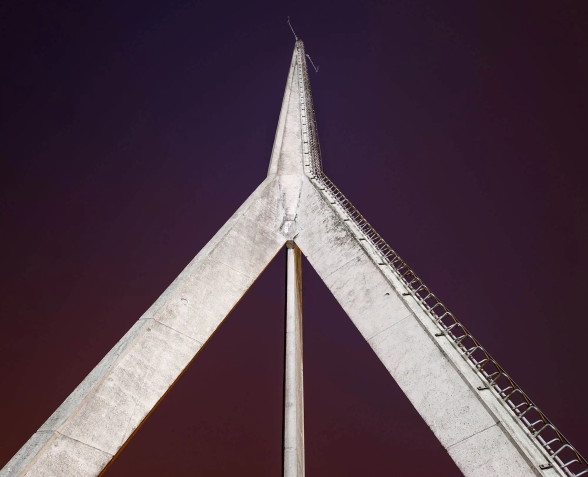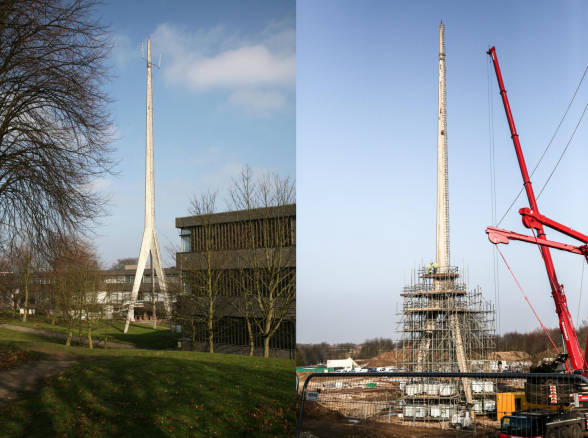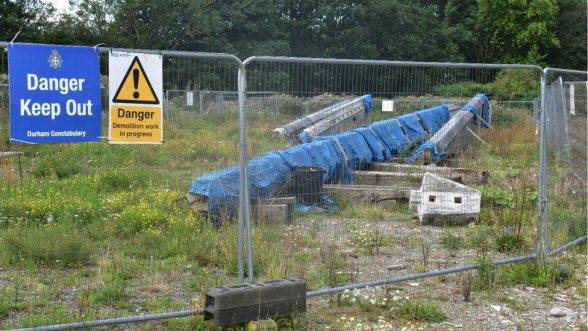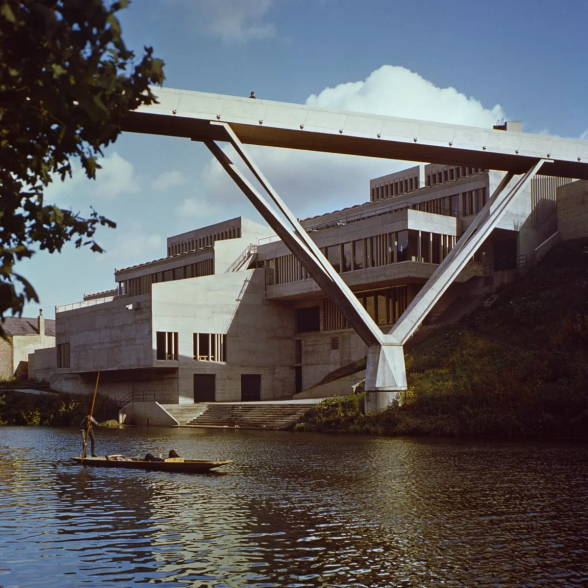This website uses cookies
This website uses cookies to enable it to function properly and to analyse how the website is used. Please click 'Close' to accept and continue using the website.



Image: James O’Davies / Historic England
A row has erupted in County Durham, over the future a Grade II listed Ove Arup designed police communications mast. Built in 1968, the ‘Skylon of the North’ was a slender Modernist icon on the Durham skyline and is one part of a trilogy of the engineers’ works in the city. The elegant 160ft high concrete structure was dismantled in 2017 to make way for a new housing development on the site of the police’s former headquarters. One of the conditions on the listed building consent was that the mast be re-erected near the original site, a commitment the police force are now attempting to renege on, with C20 calling for a planning enforcement so the mast can rise again.
The £1 million mast?
In August 2022, the Durham Constabulary applied for LBC (Listed Building Consent) to demolish the components of the mast, claiming a cost of £1 million to restore and re-erect the mast, or £750,000 to build a warehouse to continue storing the components. The Police Commissioner adding the structure had “no practical, commercial, sentimental or operational value”. C20 Society, Historic England, City of Durham Trust and British Archaeological Society were among numerous objectors to the application – questioning the figures quoted and re-affirming the significant heritage value and feasibility of reinstating the mast.

Image: Northern Echo
In February 2023, Durham planning committee formally rejected the application. Councillors argued the mast was once a key part of Durham’s skyline and money received for the sale of the former police headquarters should have been saved to cover the costs of re-erection.
Councillor Liz Brown commented: “This is like someone knocking down Durham Cathedral. [It’s] an iconic listed structure, until 2017 it was on the skyline. I think the police are being disingenuous by saying: ‘oh we can’t afford it now’. The money should have been earmarked to do this.”
As the LBC was conditional on re-erection, the applicant had a duty to take it apart in a method which anticipated that and to store it in a way that minimized damage and deterioration; failure to comply with LBC is a criminal offence. Both the council and the police are now options, with both an appeal and potential enforcement action both possibilities.
Having viewed detailed images of all the components, C20’s experts on concrete conservation believe that – despite due-care clearly having not being exercised during its dismantling and storage – the mast remains in remarkably good condition and are confident the load bearing surfaces can be repaired, to allow a re-erection of the mast for significantly less than the publicly quoted costs.

Image: BBC Tyne & Wear
‘Total Design’
The County Police Communications Tower was designed and built by Ove Arup and Partners between 1965 and 1968 at Aykley Heads, the headquarters of the Durham Constabulary. It was constructed from reinforced concrete to a height of 49.5m, with three legs supporting the main mast. Precast in five elements – the mast unit, three leg units and a key unit connection – to avoid need for full height scaffolding and formwork, the tripod design also minimises any lateral movement which would distort the narrow radio frequencies. The result is an elegant form surging upward while responding sensitively to its hilltop site overlooking Durham Cathedral.
It is noteworthy that the Royal Fine Art Commission signed off the plan presented by the Arup design team, which consisted of Jack Kunz, Ken Anthony, John Martin and Yuzo Mikami. The RFAC was responsible for advising on issues of public amenity and artistic importance, and judged the Arup design to be of sufficient aesthetic merit and minimal negative impact on its surroundings for its erection to go ahead. Historic England awarded the mast Grade II status in March 2003.
The mast’s architectural interest is derived from its demonstration of Ove Arup’s philosophy of ‘total design’ integrating engineering and architecture. It is a unique, site specific design concept combining simplicity of construction with the ability to withstand high wind tolerance. The mast is understood as a technical response to a specific brief but it additionally achieves a powerful sculptural presence giving it artistic interest in its own right.

Ove Arup’s Durham Trilogy
Ove Nyquist Arup was born in Jesmond, Newcastle, in 1895 to Danish and Norwegian parents. Widely considered to be the foremost engineer of the twentieth century, he pioneered the use of new construction materials in the built environment. Over his life, Arup worked on many ground-breaking projects, such as the Sydney Opera House, the Barbican Centre in London, and the sweeping Byker Metro Bridge in Newcastle. The practice he founded continues to this day, with Arup now firmly established as one of the world’s most respected engineering firms.
In addition to its individual merits, the communications mast holds considerable group value with two other buildings engineered by Ove Arup and Partners in Durham, forming an unofficial city trilogy: Kingsgate Bridge (1963, Grade I) and Dunelm House (1965, Grade II).
Dunelm House, the University’s Brutalist student union on the banks of the River Wear, was threatened with demolition after the University applied for a Certificate of Immunity from listing in 2016. The building was finally listed in 2021, following a four year campaign and two appeals by C20. The adjacent Kingsgate Bridge was Grade I listed in 1993. The last structure personally designed by Sir Ove Arup, he believed it to be his finest work and following his death in 1988, his ashes were scattered from the bridge.
These three structures collectively narrate a spirit of post-war optimism where technological advances and mastery of the still relatively new material of reinforced concrete, announcing a bold future for the north east and Durham. There are precious few examples of such high quality twentieth-century heritage in the city, and C20 calls on the Durham Constabulary to honour their commitments so the mast can rise once again over the skyline.

Become a C20 member today and help save our modern design heritage.